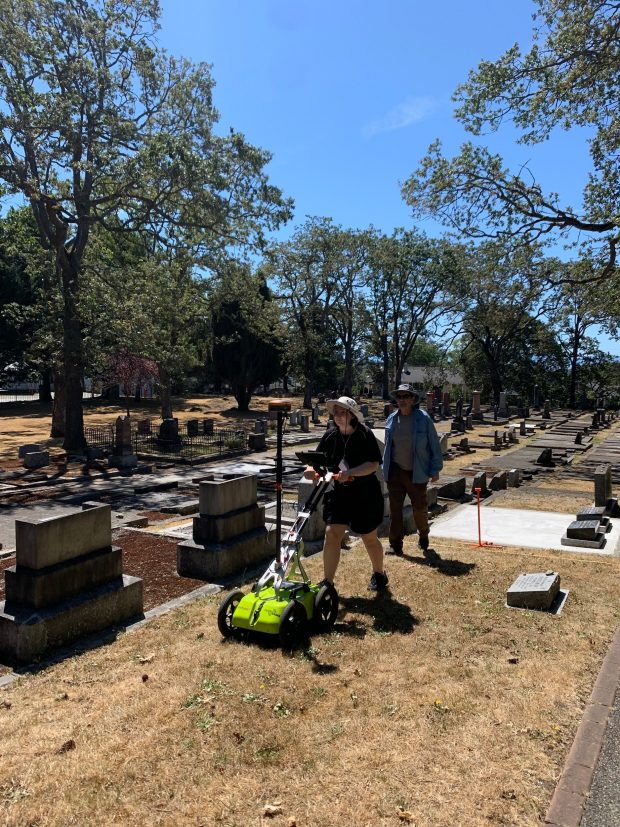Using non-invasive technology called Ground Penetrating Radar, we are able to locate unmarked graves in the subsurface without excavation or causing any kind of disturbance.
Guest post by Ash Nesbitt
Reconstructing Historical Stories
We live in a world with a rich and culturally nuanced history. Although much of it has been preserved, a great deal of it has been lost to time, swept away by natural disasters, or came and went without documentation in the first place. One particular place which is integral in preserving history is a cemetery.
Museums do a great job at articulating historical events writ large, but cemeteries contain all of the individual puzzle pieces which gave history its momentum. When you pass through the Emanu-El cemetery located on the ancestral and unceded lək̓ʷəŋən & W̱SÁNEĆ lands you are able to read a story about the first Jewish people who settled in Victoria amidst the bustling era of the late 1840’s to early 1850’s Gold Rush. And a bustling time it was, indeed. We can confirm that 483 Jewish people have been buried in the cemetery, but at least 38 of the burials have gone undocumented without any indication of the whereabouts of their plots.
Because of this loss of documentation, all we have are missing pieces of a larger portrait painted by the community’s memory and lineage clues found through sites like ancestry.ca. But as exhibited by community historian, Amber Woods, a great deal of effort has been put toward piecing these stories together.
The Assistance of Radar Technology
Aside from oral histories circulating amongst the Jewish community, we have another very useful tool for recollecting the past… in a more scientifically “rigorous” kind of pursuit. This strategy involves using radar technology which essentially looks like a super fancy lawnmower to non-invasively search the earth for differences in the soil. It is called Ground Penetrating Radar (GPR).
Sounds fun… right? Well, documenting “differences in the soil” does not just give us a stratigraphy report but also reveals differences in the matter which lies beneath our feet. This tool is handy in a cemetery context containing unmarked graves because it has the potential to tell us exactly where these missing grave sites would be to a geographical tee.
Involved in this project is Dr. Brian Whiting, the Geophysics Division Manager and an archaeologist with Geoscan. With just Brian, the Geoscan team, and our highly esteemed GPR, they have helped locate missing graves in many important sites unlocking hidden pieces of history for us to reconstruct.
Unmarked Graves and GPR
Missing burial sites are a huge concern in Canada, and has become an ever-evolving concern since the GPR detected roughly 200 unmarked graves outside of the former Kamloops residential school. While the air circulates with grief, non-invasive technology is a way to work with Indigenous communities in identifying the remains of deceased family members. We hope that this will also bring a small sense of peace to those who have been impacted by these tragedies.
All of this is to say that technology like GPR has proved to be a very effective archaeological tool. Naturally, of course, there are many exceptions to the precision of GPR. Obstacles range from issues with certain types of soil, image results that exhibit pretty bad resolution, and the unfortunate fact that the radar cannot detect human remains, just to name a few. In this case scenario, the GPR is vital in altering us where not to dig when providing newer plots for the recently deceased. This is the closest tool we have to avoiding grave disturbance.
To stay engaged with the results of this Heritage Archaeological project, I invite you to stay updated by following our course blog. As Jeremy Frankel writes, “everyone has a story waiting to be told”. It is the job of the historian, archaeologist, and various community members to assist in whatever means necessary to piece together these stories and honor their cultural impact.

